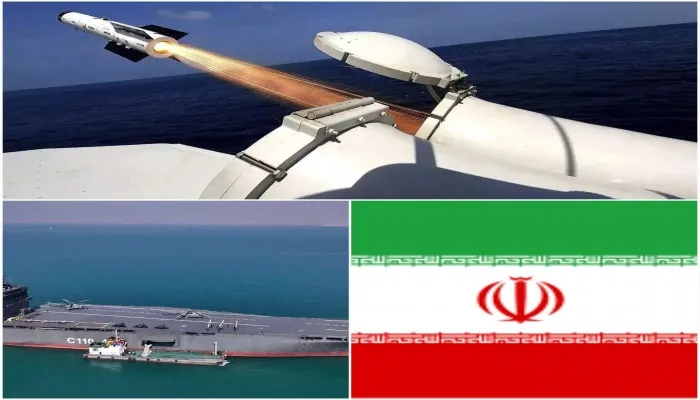Iran’s Revolutionary Drone Carrier: A New Era in Naval Warfare
In a bold and unprecedented move, Iran has taken a significant step toward reshaping global naval dynamics with the unveiling of its Shahid Pesti drone carrier. This new maritime asset is more than just a warship—it's a testament to the growing power of unmanned aerial vehicles (UAVs) in modern warfare, pushing the boundaries of naval capabilities. The drone carrier is poised to challenge Western naval dominance in the Persian Gulf and beyond, signaling Iran's increasing commitment to expanding its military prowess.

The Role of Drones in Modern Warfare
Combat drones have drastically altered the landscape of warfare in recent years. From the skies of Ukraine to the volatile regions of West Asia, drones have proven to be low-cost yet highly effective tools for precision strikes, kamikaze attacks, and continuous surveillance. These high-impact weapons have disrupted traditional military strategies and defense systems, forcing nations to rethink their approach to both offense and defense.

Ukraine's battlefields have shown how drones can neutralize billion-dollar military assets, turning the tides of conflict in unexpected ways. The flexibility of drones—from their ability to strike with precision to their role in constant surveillance—has rewritten the rules of engagement. Their proliferation in modern warfare underscores the shift toward technology-driven strategies, where unmanned systems are becoming more integral to military operations.
Iran's Bold Move: The Shahid Pesti Drone Carrier
Building on this trend, Iran has now taken the next leap in drone warfare by introducing the Shahid Pesti, a sophisticated drone carrier vessel. This development marks a significant escalation in Iran's naval capabilities and its ability to project power across the region. With this new vessel, Iran joins an elite group of nations possessing advanced naval assets capable of leveraging UAVs for a variety of military purposes.
The Shahid Pesti, which has been adapted from a commercial container ship into a formidable military asset, is designed to carry a fleet of UAVs, including the advanced Khaer drone, a miniaturized version of Iran's indigenous fighter jet. The vessel's ability to launch a wide range of drones—each serving different tactical functions—gives Iran an unprecedented strategic advantage in the region.
One of the most impressive features of the Shahid Pesti is its year-long operational range without the need for refueling. This extended operational capacity poses fresh challenges for regional military dynamics, particularly for Western forces operating in the Persian Gulf. The carrier’s versatility and endurance make it a formidable force in maritime warfare, capable of operating far from Iranian shores and exerting pressure on adversaries.
Iran's Growing Naval Innovation
The Shahid Pesti is part of a larger strategy by Iran to bolster its military capabilities in the face of rising tensions in the region. The vessel’s launch follows closely on the heels of Iran’s unveiling of an underground missile facility, which houses hundreds of cruise missiles capable of countering enemy destroyers and engaging in electronic warfare. This facility adds another layer of deterrence to Iran’s military arsenal, giving it the ability to challenge even the most advanced foreign military assets.
In addition to the missile facility, Iran's Revolutionary Guard Corps has disclosed the existence of an underground naval base for assault boats in the country’s southern waters, including the strategic Strait of Hormuz. These facilities are part of Iran’s broader strategy to ensure its readiness for any potential conflict and to project power in key maritime chokepoints.
The timing of these revelations—amidst escalating regional tensions—sends a clear message: Iran is prepared to defend its interests and assert its dominance over key maritime routes. The Islamic Republic’s actions come at a time when tensions with the West are high, particularly concerning the status of its nuclear program.
Geopolitical Implications: Iran's Military Strategy and U.S. Relations
The rise of Iran as a major naval power comes at a time of heightened geopolitical uncertainty. Former U.S. President Donald Trump’s stance on Iran remains clear: the country cannot be allowed to develop nuclear weapons. Trump has reiterated his commitment to preventing Iran from obtaining nuclear capabilities, even as he has expressed a desire for peace and a potential resolution to the nuclear impasse.
In 2018, Trump withdrew the United States from the Joint Comprehensive Plan of Action (JCPOA), a landmark nuclear deal between Iran and several world powers. He reimposed stringent sanctions on Iran, aiming to curb its nuclear ambitions and limit its military activities. This decision, however, has contributed to strained relations between Iran and the U.S., with both sides engaging in a tense standoff over nuclear proliferation and regional influence.
Despite these tensions, Trump has stated that he hopes for peace with Iran, emphasizing that the country’s future could be prosperous if it chooses to abandon its nuclear aspirations. This diplomatic ambiguity presents both opportunities and challenges for the future of U.S.-Iran relations.
As Iran continues to build its military capabilities—both on land and at sea—it remains to be seen whether diplomatic efforts will yield results or if tensions will escalate further. The Shahid Pesti drone carrier, along with Iran's growing missile and naval assets, signals a shift in the balance of power in the region. The Islamic Republic’s ability to adapt to modern warfare technologies and develop indigenous military solutions puts it in a stronger position to defend its interests and assert influence in the Persian Gulf.
The Future of Naval Warfare
The introduction of drone carriers like the Shahid Pesti represents a pivotal moment in the evolution of naval warfare. With the growing reliance on unmanned systems, nations around the world are reassessing their military strategies to incorporate these low-cost yet highly effective technologies. As drones continue to reshape the battlefield, the future of warfare may look increasingly dominated by these advanced and versatile systems.
Iran’s latest move underscores a larger trend of military innovation in the region, with drone warfare playing a central role in modern conflicts. The ability to project power without risking human lives has made drones indispensable in the arsenals of nations worldwide. As the Shahid Pesti and other drone assets come into play, the rules of engagement in the Persian Gulf and beyond will continue to evolve, with drones at the forefront of this transformation.
In the coming years, it will be interesting to see how Western nations respond to Iran's growing military capabilities and how this will affect the broader dynamics of international relations in the Middle East. The stage is set for a new era of naval warfare, where drones will be the dominant force on the seas.
What's Your Reaction?
















